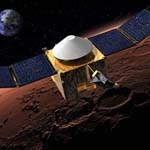Maven to Mars

Maven to Mars
Closer to Mars, as we are now, Space has always been a great mysterious thing for human beings. The farther it is, the closer we want to reach. Exploring hidden things in space has been one the most exciting job for us. With this new successful step taken by NASA, we are a step closer to revealing the secrets of the red planet. Mars is the planet which has kept us more curious either for guesses of existence of life there or for the presence of water in the atmosphere. To get a clearer answer of these questions, NASA has sent its Mars Atmosphere and Volatile Evolution (MAVEN) spacecraft, which successfully entered Mars orbit. It will now study the Mars’ upper atmosphere for which MAVEN is specially designed.

Picture Link : http://bit.ly/1rif5dF
The journey took ten months for the insertion of MAVEN into Martin’s atmosphere. The tracking data were received by NASA’s Deep Space Network antenna stationed in Canberra, Australia. MAVEN is 11.43 meters in length, long like a bus, carries a dry mass of 903 kilograms, a wet mass of 2,550 kilograms, and is capable of producing 1,135 watts (in orbit of Mars) from its photovoltaic solar arrays.
The launch of Maven was announced on 15 September 2008.The spacecraft was jointly constructed by Lockheed by the University of California at Berkeley with support from CU/LASP and Goddard, contains six instruments that will characterize the solar wind and the ionosphere of the planet. The Remote Sensing Package, built by CU/LASP, will identify characteristics present throughout the upper atmosphere and ionosphere. The Neutral Gas and Ion Mass Spectrometer, provided by Goddard, will measure the composition and isotopes of atomic particles. After five years of construction and testing, MAVEN has been successfully reached mars atmosphere on Sunday 21st September 2014.

Picture Link : http://bit.ly/XZHjj1
MAVEN will help us to know more about the history of Martian atmosphere’s climate change over a period of time and how the evolution of the surface and the habitat developed. It will also help us to acquire knowledge about how to send human beings to Mars, according to the planned ‘Future Mission to Send Humans to Mars’ in 2030s.
The primary mission includes five “deep-dip” campaigns in which MAVEN’s lowest orbit altitude will be lowered from 93 miles (150 kilometers) to about 77 miles (125 kilometers). These measurements will provide information down to where the upper and lower atmospheres meet, giving scientists a full profile of the upper tier.







